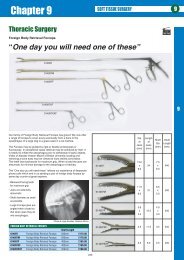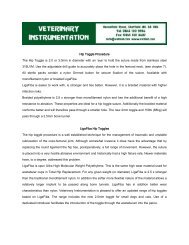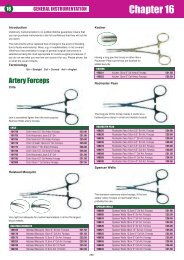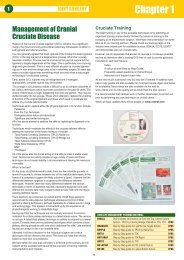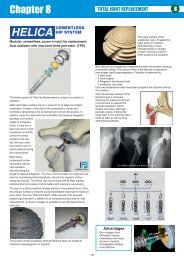Cardell MAX-12 HD - Veterinary Instrumentation
Cardell MAX-12 HD - Veterinary Instrumentation
Cardell MAX-12 HD - Veterinary Instrumentation
You also want an ePaper? Increase the reach of your titles
YUMPU automatically turns print PDFs into web optimized ePapers that Google loves.
<strong>Cardell</strong>® <strong>MAX</strong>-<strong>12</strong><strong>HD</strong> User’s Manualstructure and may actually feel a pulsation as the needle tip engages the arterialwall. At this point, a “flash” may be noted in the needle hub. Once the “flash”is noted, stabilize the catheter unit. If you are using a guide wire catheter,slowly advance the wire stylette. It should move easily or only encounter slightresistance if you are in the vessel lumen. Once the guide wire is inserted fulllength, slowly advance the catheter until the catheter hub is at the skin surface.If using a standard catheter, slowly advance the catheter. There should be slightresistance due to tissue “drag” but the catheter should go smoothly. Aftercatheter placement is confirmed, gently compress over the vessel at thecatheter tip, remove the stylette and needle, and cap the catheter hub with theadapter. An initial aspiration should easily produce a blood “flash” into thesaline solution. Flush in 2-3 cc of heparinized saline solution to clear bloodfrom the catheter lumen. Secure the catheter in place prior to proceedingfurther.Connection to BP monitor: Flush the connecting tubing with saline using theflush device embedded in the disposable transducer or by using a saline filledsyringe attached to the stopcock immediately adjacent to the extension tubing.Be sure that there are no visible air bubbles following the flush procedure.Attach the connecting tubing to the catheter adapter extension. You should seea pressure waveform on the monitor screen after opening the stopcocks to thesystem. Level the transducer at the estimated base of the heart (point of theshoulder). Close the line to the patient and open it up to room air using thestopcock. Press the zero button again to recalibrate the system to the patient.Close the stopcock to air and open the line to the patient. You are nowmeasuring direct blood pressure.Blood pressure waveformArterial waveforms emanate from the pulse pressure created by ventricularsystole and diastole. The arterial pulse pressure wave begins as left ventricularcontraction and forward blood flow (stroke volume) creates aortic distentionwithin the closed vascular system. Peak aortic blood flow produces the initialupstroke in the pressure pulse while continuous ejection of blood from theventricle during systole fills out or sustains the pulse waveform. As pressureand flow reach their maximum values, the curve flattens and reaches peakpressure. The rounded, sustained portion of the pressure wave represents acombined effect of ventricular volume ejection, distention of the entire aorta,<strong>12</strong>6 M1.0 5-15-09



